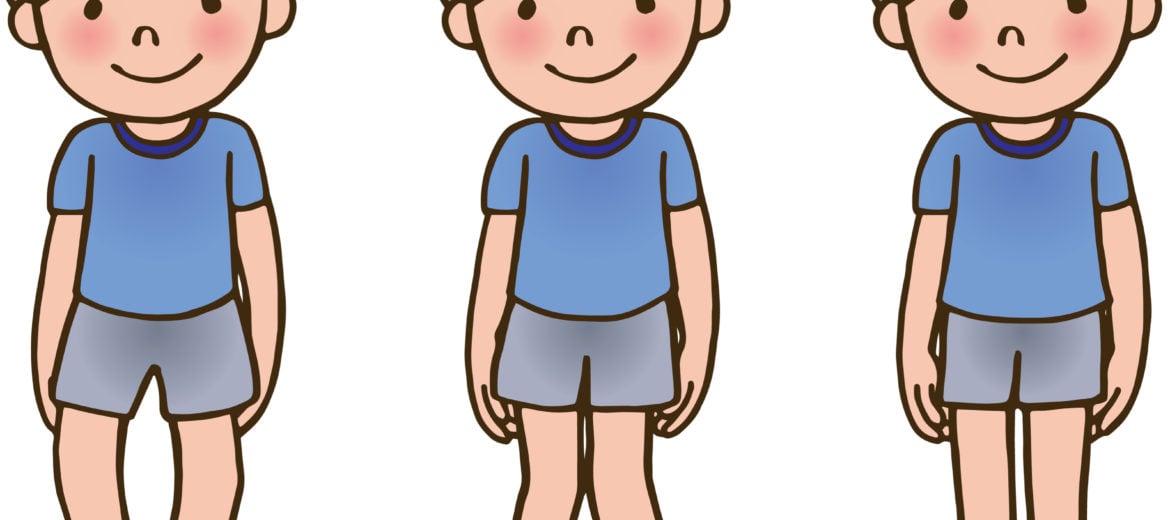Ruchita Shah was extremely worried when she realized that her 3 year old son’s bow legs had not straightened despite many visits to her pediatrician. She decided to travel from Raipur to Delhi to meet a pediatric orthopedist.
What are bow legs?
Bowed legs tend to occur when the knees are turned outward even when the feet are placed together, giving the appearance of a bow.
What is the cause of bow legs?
In most cases, bowed legs are caused by physiological changes but in a few cases, the condition could be caused by medical conditions such as Rickets or Blount’s disease.
Normally children show maximum bowing at 6 to 12 months which then gradually corrects on its own somewhere between 1-1/2 and 2 years. It is usually after 2 years, that normal adult alignment of legs can be expected.
How do you know if your child has bow legs?
The symptoms of bow legs are:
- the shape or appearance of a bow formed when infants and toddlers have both feet together
- in-toeing or the inward turning of the feet, which often appears with bowleggedness
- generalised bony pains
- difficulty in walking
If you notice the following symptoms of bow legs after your child turns two years, you should visit the hospital:
- knees that do not meet when the child is standing with their feet and ankles together
- extreme/symmetrical bowing in both legs
- bowing in only one leg
- knee pain not caused by injury
Ruchika’s son’s legs had the characteristic shape that gives the condition its name.
“Most cases of bowleggedness resolve by the age of 2 years, so it’s good that Ruchika sought help when she didn’t notice an improvement in her son’s condition, ” said Dr Gourav Jandial, Pediatric Orthopedician at Sitaram Bhartia Hospital in Delhi.
“I asked my elders, friends and family on how to correct bow legs naturally but when nothing worked, I thought it maybe best to get a second expert opinion,” said Ruchika.
How are bow legs diagnosed?
A pediatric orthopedic surgeon will
- Physically examine your child to measure the curve of the bow and understand the extremity of the case.
- Recommend blood tests to check if there’s a deficiency of vitamin D.
- Advise an X-ray to evaluate the presence of Blount’s disease (usually in the case of bowing in one leg)
You may be asked to get more tests to make sure there are no some systemic metabolic disease affecting the legs.
Can bow legs be corrected?
Yes, bow legs can be corrected. The options for treatment differ depending on age and severity.
Treatment for Bow Legs in Babies
When the condition is diagnosed in infants, doctors recommend a wait and watch approach.
“We ask parents to return for a check-up every six months because in most cases the condition disappears with time. In case the condition persists, your child’s pediatrician will refer you to a pediatric orthopedic specialist for expert help,” stated Dr Gourav.
Treatment for Bow Legs in Toddlers and Older Children
If the condition causing bowlegs is found to be Rickets, parents are advised to alter their child’s diet by increasing the intake of foods rich in vitamin D and calcium along with their medical supplements. Surgery might be required in a few cases if the bowing does not correct even after vitamin D correction has been achieved.
If the cause of bowlegs is not physiological/ due to vitamin D deficiency and is due to Blount’s diseases, then it needs to be tackled aggressively with surgery.
Ruchika’s son was found to have Rickets that caused severe bowing of the legs. After thoroughly investigating the condition and understanding the boy’s medical history in-depth, Dr Gourav suggested supplements for vitamin D and strict intake of calcium in every meal.
With help from the Child Health Counselors at Sitaram Bhartia, Ruchika was able to reinforce the benefits of foods like curd, cottage cheese (paneer) milk, eggs, brocolli and soya beans to her son. They also helped her come up with ways to make the food attractive so that the child does not make a fuss about eating them.
“The tips and tricks the counsellors taught me were very useful. Within 2 years, my boy’s legs straightened and his overall health improved. I couldn’t be happier!” exclaimed Ruchika in a follow-up visit.
Tips for dealing with bow legs in children
If your child has bowlegs, keep in mind these simple tips:
- Eat the right foods: It always helps to focus on the right foods from an early age. Incorporate healthy doses of milk or curd in every meal toward your child’s vitamin D and calcium requirements. This will increase the chances of straightening the bent legs in your child (if the cause is vitamin D deficiency).
- Take follow ups seriously: Regular check ups help the doctor understand your child’s progress and what action is required to improve their condition further. Don’t miss these appointments!
- Speak positively: It can be frustrating when things don’t go the way you would like them to. But try not to complain about the problems your child is facing and instead provide emotional support and stability through reassuring words.
- Monitor your child’s weight: You should consider visiting a pediatric endocrinologist if efforts to reduce weight do not help.
If you’re looking for help for your child’s bow legs, come in for an appointment with our pediatric orthopedician today! Please call us on +91 8826391002 to schedule a consultation.


